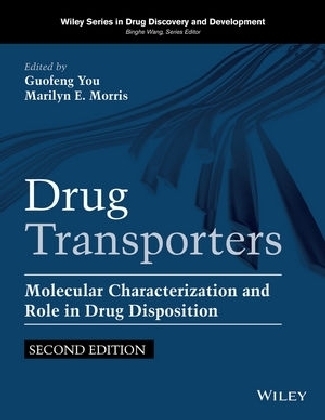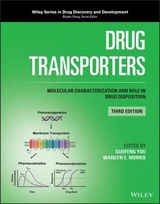
Drug Transporters
John Wiley & Sons Inc (Verlag)
978-1-118-48993-2 (ISBN)
- Titel erscheint in neuer Auflage
- Artikel merken
This new edition overviews drug transporters and presents the principles of drug transport and associated techniques, featuring new chapters on multidrug and toxin extrusion proteins, placental transport, in silico approaches in drug discovery, and regulatory guidance for drug transport studies in drug development. Describes drug transporter families, mechanisms, and clinical implications along with experimental methods for studying and characterizing drug transporters Includes new chapters on multidrug and toxin extrusion proteins, placental transport and in silico approaches in drug discovery Has a new chapter covering regulatory guidance for the evaluation of drug transport in drug development with global criteria used for drug transporters in clinical trials Arranges material to go from fundamental mechanisms to clinical outcomes, making the book useful for novice and expert readers
Guofeng You is a Distinguished Professor of Pharmaceutics in the Ernest Mario School of Pharmacy at Rutgers University, USA. She has published numerous original research articles in the field of drug transport. She has been serving on several grant review panels of the National Institutes of Health and is on the editorial boards of leading journals. She was the coeditor for the first edition of this book (Wiley, 2007). Marilyn E. Morris is Professor in the Department of Pharmaceutical Sciences at the University at Buffalo, State University of New York. She is a Fellow of the American Association of Pharmaceutical Scientists (AAPS) and the American Association for the Advancement of Science (AAAS). and currently serves on the editorial boards of leading journals and was also co-editor for the first edition of this book (Wiley, 2007).
Preface to the Second Edition xvii Preface to the First Edition xix List of Contributors xxi 1 Overview of Drug Transporter Families 1 Guofeng You and Marilyn E. Morris 1.1 What Are Drug Transporters? 1 1.2 Structure and Model of Drug Transporters 1 1.3 Transport Mechanisms 2 1.4 Polarized Expression of Drug Transporters in Barrier Epithelium 2 1.5 Classifications of Drug Transporters 2 1.6 Regulation of Drug Transporters 4 References 4 2 Organic Cation and Zwitterion Transporters (OCTs, OCTNs) 7 Hermann Koepsell 2.1 Introduction 7 2.2 hOCT1 (SLC22A1), hOCT2 (SLC22A2), and hOCT3 (SLC22A3) 7 2.3 hOCTN1 (SLC22A4) and hOCTN2 (SLC22A5) 17 2.4 hOCT6 (SLC22A16) 20 2.5 Conclusions 20 References 21 3 Organic Anion Transporters 25 Kevin T. Bush, Megha Nagle, David M. Truong, Vibha Bhatnagar, Gregory Kaler, Satish A. Eraly, Wei Wu and Sanjay K. Nigam 3.1 OAT Family 25 3.2 Molecular Characterization 27 3.3 Expression and Regulation of OATs 29 3.4 OAT Substrates 32 3.5 Systems Biology of OATs 35 3.6 Conclusions 37 Acknowledgments 37 References 37 4 Organic Anion-Transporting Polypeptides 43 Rommel G. Tirona and Richard B. Kim 4.1 Introduction to the OATP Superfamily 43 4.2 Molecular Characteristics of OATPs 44 4.3 Expression and Regulation of OATPs 45 4.4 OATP Substrates and Inhibitors 48 4.5 Pharmacology of OATPs 53 4.6 Physiological/Pathophysiological Roles 57 4.7 Conclusions 58 Acknowledgments 58 References 59 5 Peptide Transporters 67 Stephen M. Carl, Dea Herrera-Ruiz, Rajinder K. Bhardwaj, Olafur Gudmundsson and Gregory T. Knipp 5.1 Introduction 67 5.2 Molecular and Structural Characteristics 69 5.3 Functional Properties 73 5.4 Regulation 74 5.5 Pharmaceutical Drug Screening 80 5.6 Concluding Remarks 83 Acknowledgments 84 References 84 6 Monocarboxylic Acid Transporters 91 Zejian Liu and Lester R. Drewes 6.1 Introduction 91 6.2 Mitochondrial Pyruvate Transporter Family 91 6.3 SLC5 Transporter Family 92 6.4 SLC16 Transporter Family 93 References 99 7 The Nucleoside Transporters CNTs and ENTs 107 Horace T. B. Ho and Joanne Wang 7.1 Introduction 107 7.2 Molecular and Functional Characteristics of CNTs (SLC28) 107 7.3 Molecular and Functional Characteristics of ENTs (SLC29) 112 7.4 Regulation of CNT and ENT Nucleoside Transporters 116 7.5 Physiological and Pathophysiological Functions of CNTs AND ENTs 117 7.6 Therapeutic Significance of CNTs and ENTs 119 7.7 Conclusions and Future Directions 120 Acknowledgment 121 Abbreviations 121 References 121 8 Bile Salt Transporters 127 Jyrki J. Eloranta, Bruno Stieger and Gerd A. Kullak-Ublick 8.1 Overview of the Enterohepatic Circulation of Bile Salts 127 8.2 The Chief Transporters in the Enterohepatic Circulation of Bile Salts 127 8.3 Enterohepatic Bile Salt Transporters in Liver Disease 129 8.4 Control of Bile Salt Transport and Metabolism 130 8.5 N uclear Receptors as Transcriptional Regulators of Bile Salt Homeostasis 130 8.6 FXR-Dependent Mechanisms That Regulate Human Bile Salt Transporter Genes 132 8.7 Cross Talk between the Transcriptional Control of Bile Salt and Drug Transporters 135 8.8 Concluding Remarks and Future Perspectives 135 References 135 9 Multidrug Resistance Protein: P-Glycoprotein 141 Adam T. Clay and Frances J. Sharom 9.1 The P-Glycoprotein Gene Family 141 9.2 Tissue Distribution of P-Glycoprotein 141 9.3 Role of P-Glycoprotein in Human Physiology 141 9.4 P-Glycoprotein Substrates and Modulators 143 9.5 P-Glycoprotein Structure 143 9.6 Subcellular Systems for Studying P-Glycoprotein 146 9.7 ATP Binding and Hydrolysis by P-Glycoprotein 147 9.8 Drug Binding by P-Glycoprotein 148 9.9 P-Glycoprotein-Mediated Drug Transport 148 9.10 Substrate Specificity of P-Glycoprotein and the Nature of the Drug-Binding Site 149 9.11 P-Glycoprotein as a Hydrophobic Vacuum Cleaner or Drug Flippase 150 9.12 Role of the Lipid Bilayer in P-Glycoprotein Function 151 9.13 Mechanism of Action of P-Glycoprotein 153 9.14 Role of P-Glycoprotein in Drug Therapy 154 9.15 Modulation of P-Glycoprotein in Cancer Treatment 154 9.16 Regulation of P-Glycoprotein Expression 155 9.17 P-Glycoprotein Gene Polymorphisms and Their Implications in Drug Therapy and Disease 155 9.18 Summary and Conclusions 156 References 157 10 Multidrug Resistance Proteins of the ABCC Subfamily 161 Anne T. Nies and Thomas Lang 10.1 Introduction 161 10.2 Molecular Characteristics 162 10.3 Functional Properties, Substrate Specificity, and Multidrug Resistance Profiles of Human ABCC/MRPs 163 10.4 Localization of ABCC/MRP Efflux Transporters in Normal Human Tissues and in Human Cancers 167 10.5 Genotype Phenotype Correlations and Clinical Consequences of Genetic Variants in ABCC Genes 171 10.6 Conclusions and Future Prospects 178 Acknowledgments 179 References 179 11 Breast Cancer Resistance Protein (BCRP) or ABCG2 187 Agnes Basseville, Robert W. Robey, Julian C. Bahr and Susan E. Bates 11.1 Discovery and Nomenclature 187 11.2 ABCG2 Gene and Expression 187 11.3 Physical Properties 191 11.4 Substrates/Inhibitors of ABCG2 194 11.5 Recent Findings in Physiological Function 195 11.6 Predicted Physiological Function from Tissue Distribution 199 11.7 ABCG2 Expression in Cancer and Its Role in Drug Resistance 202 11.8 Genetic Polymorphisms 205 11.9 Conclusion 208 References 208 12 Multidrug and Toxin Extrusion Proteins 223 Stephen H. Wright 12.1 Introduction 223 12.2 Tissue and Subcellular Distribution of MATEs 225 12.3 Functional Characteristics of MATE Transporters 226 12.4 Kinetics and Selectivity of MATE-Mediated Transport 227 12.5 Molecular/Structural Characteristics of MATE Transporters 233 12.6 Regulation of MATE and Activity 236 12.7 Influence of MATEs on Renal OC Clearance and Clinical Drug Drug Interactions 237 12.8 Conclusions 238 Acknowledgments 238 References 238 13 Drug Transport in the Liver 245 Brian C. Ferslew, Kathleen Kock and Kim L. R. Brouwer 13.1 Hepatic Physiology: Liver Structure and Function 245 13.2 Hepatic Uptake Transport Proteins 245 13.3 Hepatic Efflux Transport Proteins 247 13.4 Regulation of Hepatic Drug Transport Proteins 249 13.5 Disease State Alterations in Hepatic Transport Proteins 253 13.6 Model Systems for Studying Hepatobiliary Drug Transport 255 13.7 Drug Interactions in Hepatobiliary Transport 260 13.8 Interplay between Drug Metabolism and Transport 262 13.9 Hepatic Transport Proteins as Determinants of Drug Toxicity 263 13.10 The Future of Hepatic Drug Transport 263 Acknowledgments 264 References 264 14 Drug Transport in the Brain 273 Tamima Ashraf, Patrick T. Ronaldson and Reina Bendayan 14.1 Introduction 273 14.2 Physiology of the Brain Barriers and Brain Parenchyma 273 14.3 Functional Expression of Drug Transporters in the Brain 274 14.4 Relevance of Drug Transporters in CNS Disorders 283 14.5 Regulation of Drug Transporters by Nuclear Receptors in the Brain 289 14.6 Conclusion 290 References 291 15 Drug Transport in the Kidney 303 Hiroyuki Kusuhara, Takashi Sekine, Naohiko Anzai and Hitoshi Endou 15.1 Introduction 303 15.2 Families of Renal Drug Transporters 305 15.3 Regulation of Renal Drug Transporters 310 15.4 Pharmacokinetic and Pharmacological/Toxicological Aspects 312 15.5 In Vitro Model Systems for Studying Renal Drug Transport 315 15.6 FDA and EMA Draft Guidance/Guideline for Drug Drug Interaction Studies 316 15.7 Perspectives 316 References 316 16 Drug Transporters in the Intestine 327 Patrick J. Sinko 16.1 Introduction 327 16.2 Intestinal Drug Permeation 327 16.3 Drug Transporters in the Small Intestine 329 16.4 Impact of Small Intestinal Transporters on Oral Absorption of Drugs 331 16.5 Functional Modulation of Intestinal Transporters to Optimize Oral Absorption of Drugs 335 16.6 Concluding Remarks 335 References 335 17 Drug Transport in the Placenta 341 Qingcheng Mao, Vadivel Ganapathy and Jashvant D. Unadkat 17.1 Introduction 341 17.2 Blood Placental Barrier Relevant to Drug Permeability and Transport 341 17.3 Drug Transporters in Human Placenta 342 17.4 Methods to Study Placental Drug Transport 348 17.5 Summary 349 References 350 18 Experimental Approaches to the Study of Drug Transporters 355 Yoshiyuki Kubo, Akira Tsuji and Yukio Kato 18.1 Introduction 355 18.2 In Vivo Experiments 355 18.3 Isolated Tissue Methods 358 18.4 Primary Cell Cultures and Established Model Cell Lines 359 18.5 Membrane Vesicles 362 18.6 Analysis of Drug Interaction Mechanisms 363 18.7 Perspectives 364 References 365 19 Transporters in Drug Discovery: In Silico Approaches 371 Ayman El-Kattan, Manthena V. Varma and Yurong Lai 19.1 Introduction 371 19.2 Physicochemical Determinants of Hepatobiliary Elimination 371 19.3 In Silico Models for Biliary Excretion 373 19.4 Physicochemical Determinants of Renal Elimination 375 19.5 In Silico Models of Renal Excretion 375 19.6 PhysiCochemical Determinants of Brain Penetration 376 19.7 In Silico Approaches and SAR of Clinical Relevant Transporters 377 19.8 Strategies to Assess Transporter Involvement during Drug Discovery 381 19.9 Conclusions 382 References 382 20 Polymorphisms of Drug Transporters and Clinical Relevance 389 Aparna Chhibber, Janine Micheli and Deanna L. Kroetz 20.1 Genetic Variation and Drug Response 389 20.2 Genetic Variation in Membrane Transporters 390 20.3 Functional Analysis of Transporter Variants 391 20.4 Clinical Significance of Transporter Variants 394 References 398 21 Diet/Nutrient Interactions with Drug Transporters 409 Xiaodong Wang and Marilyn E. Morris 21.1 Introduction 409 21.2 Diet/Nutrient Interactions with Drug Transporters 409 21.3 Conclusions 425 Acknowledgments 427 References 427 22 Clinical Relevance: Drug Drug Interactions, Pharmacokinetics, Pharmacodynamics, and Toxicity 433 Serena Marchetti and Jan H. M. Schellens 22.1 Introduction 433 22.2 Interactions Mediated by ABC Drug Transporters 433 22.3 Interactions Mediated by Organic Anion and Cation Transporters (Solute Carrier Family, SLC22) 444 22.4 Interactions Mediated by Peptide Transporters (PEPTs, SLC15) 453 22.5 Interactions Mediated by Multidrug and Toxin Extrusion Transporters (MATEs, SLC47) 455 22.6 Interactions Mediated by Monocarboxylate Transporters (MCTs, SLC16) 457 22.7 Interactions Mediated by Nucleoside (Concentrative and Equilibrative) Transporters (CNTs/ENTs, SLC28/29) 458 22.8 Conclusions 460 References 461 23 Regulatory Science Perspectives on Transporter Studies in Drug Development 473 Sue-Chih Lee, Lei Zhang and Shiew-Mei Huang 23.1 Introduction 473 23.2 Regulatory Science Perspectives on Transporter Studies 474 23.3 Recent FDA NDA Review Examples 483 23.4 Conclusion and Future Directions 486 Acknowledgments 486 Abbreviation List 486 References 487 Index 491
| Erscheint lt. Verlag | 21.10.2014 |
|---|---|
| Reihe/Serie | Wiley series in drug discovery and development |
| Mitarbeit |
Herausgeber (Serie): Binghe Wang |
| Verlagsort | New York |
| Sprache | englisch |
| Maße | 218 x 284 mm |
| Gewicht | 1486 g |
| Themenwelt | Medizin / Pharmazie ► Medizinische Fachgebiete ► Pharmakologie / Pharmakotherapie |
| Naturwissenschaften ► Biologie ► Biochemie | |
| Naturwissenschaften ► Biologie ► Genetik / Molekularbiologie | |
| Naturwissenschaften ► Chemie | |
| Technik | |
| ISBN-10 | 1-118-48993-4 / 1118489934 |
| ISBN-13 | 978-1-118-48993-2 / 9781118489932 |
| Zustand | Neuware |
| Informationen gemäß Produktsicherheitsverordnung (GPSR) | |
| Haben Sie eine Frage zum Produkt? |
aus dem Bereich



